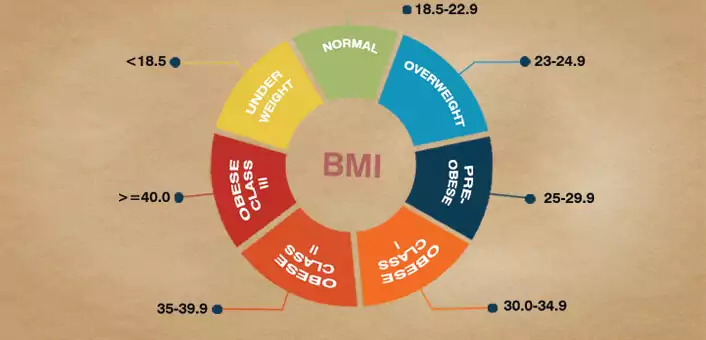
Living Well
Why A Healthy Waist Size Should Be Your Biggest Concern?
Sep 1, 2017Today, most of us are already aware that obesity leads to a variety of chronic diseases. But did you know that a healthy waist size may be the most important factor in your health and wellness?
I meet so many men and women at the gym who are obsessed with losing weight. They want to see the number on the scale go down! They constantly worry their BMI is too high and they need to drop their weight. However, they don’t really care whether their waist size is healthy. More often than not, the waist stays hidden behind clothes, and many of us tend to ignore it. However, scientists and doctors now agree that waist size may be a better predictor of good health when compared to BMI.
Why Your Waist Size Matters?
Carrying weight around the waist is a clear sign of visceral fat. Visceral fat wraps around organs, interrupting with their regular function. This abdominal fat is linked to diabetes, heart disease, metabolic disturbances and sleep apnea.
High visceral fat sends a toxic stream of chemicals into the body leading to inflammation. It also increases your risk to high cholesterol levels & high blood pressure — both of which affect your heart health.
What Should Your Waist Size Be?
Before we discuss the healthy range for waist size, let’s first learn how to measure your waist size correctly. Use a measuring tape and measure around your natural waistline (and not where you button your jeans; that’s further below). This is where your waist comes in naturally and is slimmest – above the belly button and right underneath the rib cage. Make sure your posture is straight and you aren’t slouching.
According to the American Heart Association, an unhealthy waist size increases the risk of chronic diseases like diabetes and heart disease. A waist size of more than 35 inches (or 88 cm) in women and over 40 inches (or 102 cm) in men is considered as unhealthy. The ideal waist size would be 32 ½ inches for women and 35 inches for men.
How To Reduce Waist Size?
Now that you have measured your waist size and have new goals, don’t become obsessed with sit-ups and crunches!!! Contrary to popular belief, these will not make your belly fat disappear. A good core workout will strengthen your core, but it can’t help you spot-reduce weight from just your waist. Here is how you can trim belly fat:
- Nothing beats regular moderate intensity cardiovascular activity to lose weight. A cardio HIIT workout is also very effective, if you’re short on time.
- Weight training is an effective way to slim your waistline. Lift weights thrice a week. You can also do a core workout to engage abdominal muscles and strengthen them, which will help melt fat in that area.
- Cut out fructose from your diet completely, as it contributes to abdominal obesity. This sugar is often found in sports drinks, juices, sodas and processed foods.
- Concentrate on eating a varied diet comprising of real, organic, whole foods. Fill up your plate with seasonal vegetables and fruits. And choose healthy grains like whole-wheat, buckwheat, quinoa and brown rice. We highly recommend the LCHF (Low carb-high fat) diet to improve insulin-resistance and lose belly fat.
- Healthy fats are a must in your diet. Not only do they help you feel satiated, they can also help burn belly fat. A good example is coconut oil. Made from medium chain fatty acids (MCFA), coconut oil is quickly metabolized for energy. MCFA’s are less likely to be stored as fat in the body. Add a spoonful of virgin, cold-pressed coconut oil to every meal.
- Irregular sleep is tied to increased visceral fat. So make sure you get 7 to 8 hours of restful sleep every night. Also, manage stress levels with regular yoga and meditation practice.
BMI Is An Inaccurate Method; Focus On Your Waist Size Instead
Worried about chronic diseases like diabetes and heart disease? Losing weight is important, but where your body fat is stored is equally important. British researchers now recommend that height and waist measurements are the best way to measure good health. These factors help in figuring out the risk for diabetes and heart disease. According to them, the best way to stay healthy is to make sure your waist circumference is less than half your height.
Research done at Queen’s University, Canada now shows that your waist size is a better, and more accurate, predictor of your heart health when compared to BMI. Another study done in Netherlands concluded the same. Larger waist circumference (more than 94 cm in men, 80 cm in women) identifies people at increased cardiovascular risks.
Scientists who studied survival rates in patients with CAD (coronary heart disease) found that abdominal obesity is directly associated with mortality. According to them, having a waist circumference of more than 35 inches for women and 40 inches for men is risky. It will increase the risk of death from heart disease by a whopping 70%!
Researchers at Harvard School of Public Health, Boston also found that Waist Circumference (WC) is a better predictor than Waist-Hip-Ratio (WHR) to calculate risk of type 2 diabetes. According to them, the currently recommended cut-off for WC of 102 cm for men may need to be re-evaluated. They suggest a lower cut-off may be more appropriate. Similarly, an Australian study found that abdominal fattiness appears to be a major determinant of insulin resistance in women than BMI.
In reality, where you store fat on your body is more important than the amount of fat stored in the body. This is applicable for measuring both diabetes and heart disease risks. There are several reasons that BMI is a poor predictor of good health.
- BMI doesn’t take muscle-mass into account. For example – A mesomorph will naturally have more lean muscle mass compared to an ectomorph, even if they have the same height. And even when the ectomorph may be TOFI (or Thin Outside, Fat Inside) because he/she is carrying visceral fat on the abdomen, their BMI may be low.
- BMI neglects bone weight completely. Some people have genetically heavier bones. That may add to their weight, even though they may not be carrying unhealthy abdominal fat on their body.
- BMI also doesn’t take body shape into consideration. Someone who is naturally an apple shape (people who tend to carry extra weight around their belly) may have a similar BMI to a pear shape (people who tend to carry extra weight on their hips and thighs). Yet the former is at a higher risk of heart disease and early mortality.
- BMI doesn’t always respond to healthy lifestyle changes. Some people tend to lose inches, not weight. I know because I am one of them. When my waist measured 35 inches, I was the same weight as I am now, even though my waist measures 31 inches. This is because I gained muscle mass, which weighs more than fat, but is denser. So while I have lost inches, the weighing scale shows the same number as earlier. As a result, my BMI is the same, even though I am much fitter and toned.
To sum it up, BMI may be a good tool for large populations because of ease of use. However, on an individual basis, if you’re going to measure just one thing – let it be your waist circumference.
So, if your biggest concern is protecting yourself from chronic diseases, stop obsessing about your weight. Some of us naturally carry more weight around the hips, arms and back. As long as your waist size is within normal range and you lead a healthy lifestyle, you’re doing a good job!!!






